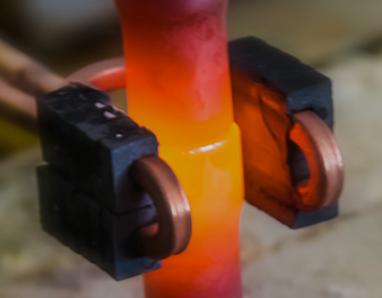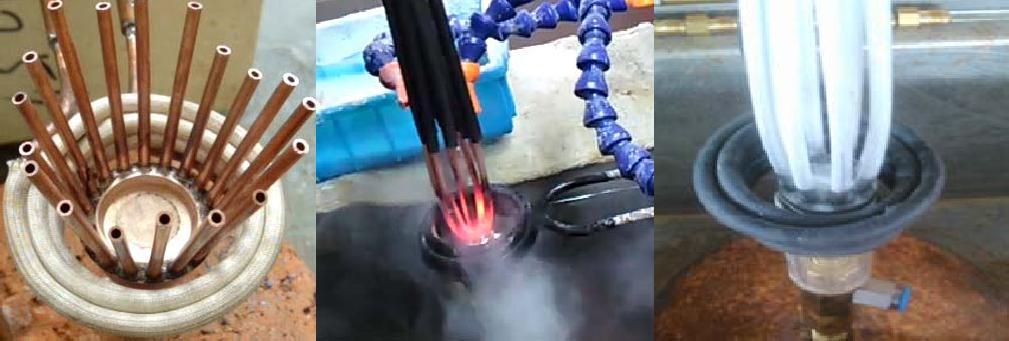Location:Home / News / Introduction to Induction Brazing
What is induction brazing
Induction brazing is the process of generating an alternating electromagnetic field around a metal part through a certain frequency of alternating current. The metal part then generates an induced current within the alternating magnetic field, and the metal material of the workpiece has a certain resistance. The current generates heat under the action of the resistance, so it is sometimes referred to as I2R loss. During induction brazing, two parts are assembled together and placed in an alternating magnetic field. As heat is generated from the inside of the workpiece, the welded joint is rapidly heated, and both workpieces, as well as the solder and flux placed at the welded joint, are simultaneously heated to the brazing temperature. The weld seam is instantly filled to form a complete brazed joint.
The actual process of induction brazing is shown in the figure

Application of induction brazing
When induction brazing, sheet, wire, powder, and paste brazing materials can be used, and brazing flux and gas medium can be used to remove the film. Induction brazing is widely used for brazing welded parts such as steel, copper and copper alloys, stainless steel, high-temperature alloys, etc. It is particularly suitable for brazing industrial products such as pipe fittings, pipes and flanges, shafts and shaft sleeves. For aluminum alloy brazing, induction brazing can also be used, but temperature control requirements are relatively high.
The advantages of induction brazing
1. Choose induced current as the heat source, with a small heating area. Usually, it can reduce the performance changes of components, such as the loss of strength of materials under tempering or annealing when connecting high-strength components. Choosing this heating method can reduce workpiece deformation and eliminate possible burning damage around the joint. But the shape of some workpieces is affected by the induction coil and cannot be heated.
Two relative heating controls can provide a flat, smooth, and uniform appearance of the joint. The joint process produced by induction brazing has strong consistency, and the alloy loss caused by heating is small. When different joints are close together, the heat control and centralized heating ability of this method can be used for sequential brazing without using brazing materials with decreasing brazing temperature. However, high precision temperature control requirements can also lead to an increase in equipment investment.
3. Fast heating speed, light discoloration of the heated workpiece, generally allowed to be heated in air, simple process, and high efficiency. Equipment without temperature and time control or inaccurate control, and too fast heating speed can also cause parts to overheat.
When needed, flexible connections can be used between sensors and control boxes to meet the requirements of brazing joints during workpiece movement. Induction brazing can be applied on production lines, allowing equipment to be arranged on assembly lines and can be remotely controlled if necessary. Automatic or semi-automatic production lines can save technical workers by using pre installed brazing materials. Using induction brazing can reduce and simplify clamping fixtures. The heating range of induction brazing is small, which increases the lifespan of the tooling used and maintains the dimensional accuracy of the connected components.
When the production is not high, simple sensors made of copper tubes can also be economically used to complete induction brazing operations.
Induction brazing


Characteristics of induction brazing applications
① The brazing material needs to be pre made into shapes such as welding rings, welding plates, etc. Before heating, it should be placed at the welding joint or embedded in the welding joint. Generally, brazing flux must be used, otherwise it should be brazed in a shielding gas or vacuum.
② Due to the short heating time, brazing materials with a small melting temperature range can be used.
③ Suitable for brazing various metal materials and dissimilar materials. Especially suitable for welding symmetrical pipe joints, flange joints, etc. Non conductive non-metallic materials such as ceramics are not suitable. Due to the advancement of technology, temperature control is becoming more and more accurate, and there are more and more occasions for using induction brazing to weld aluminum joints, but the equipment investment is slightly higher.
④ When brazing dissimilar materials, the influence of different magnetic properties and expansion coefficients should be considered.
⑤ Commonly used brazing materials include silver based, copper based, aluminum based, etc.
Popular products
News recommendations
Classification and common problems of shield tunneling tools2020-09-14
The cutting tools of shield tunneling machines can be classified according to their movement mode, arrangement position, method, and shape. According …
New type of aluminum alloy brazing material2020-09-14
The new brazing material and flux have a lower brazing temperature, which shortens the flow and filling time of the brazing material, lowers the brazi…
Brazing of aluminum and aluminum alloys2020-09-14
It should be pointed out that the process brazing performance of materials cannot be changed. With the development of brazing technology, new brazing …
Classification of brazing materials and flux2020-09-14
The main metal element in soft solder is tin, followed by lead, bismuth, zinc, gallium, antimony, cadmium, silver, copper, etc. The different combinat…
 If you have any questions or suggestions about the product, or if you want to know more, you can contact us at any time.
If you have any questions or suggestions about the product, or if you want to know more, you can contact us at any time.

Mobile website
Our Product
Contact Us